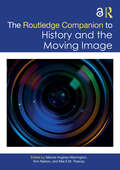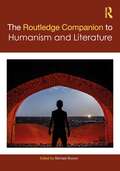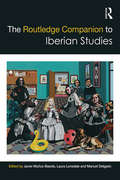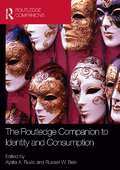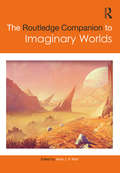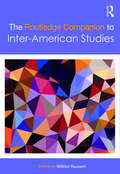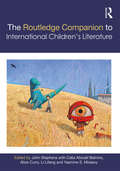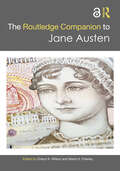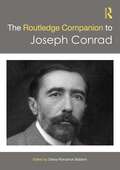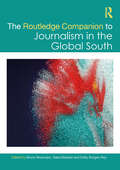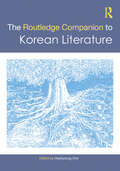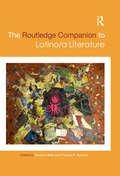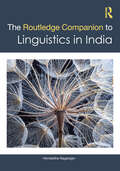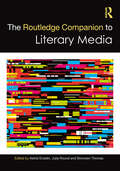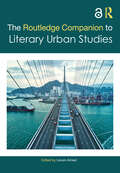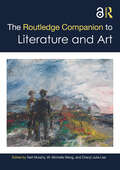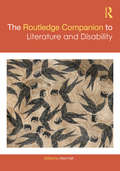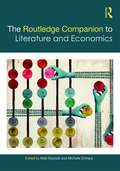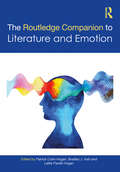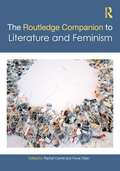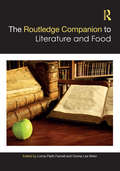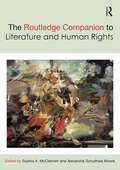- Table View
- List View
The Routledge Companion to History and the Moving Image (Routledge Companions)
by Marnie Hughes-Warrington Kim Nelson Treacey, Mia E.M.The Routledge Companion to History and the Moving Image takes an interdisciplinary approach to understanding history in moving images. It engages this popular and dynamic field that has evolved rapidly from film and television to digital streaming into the age of user-created content.The volume addresses moving image history through a theoretical lens; modes and genres; representation, race, and identity; and evolving forms and formats. It brings together a range of scholars from across the globe who specialize in film and media studies, cultural studies, history, philosophy of history, and education. Together, the chapters provide a necessary contemporary analysis that covers new developments and questions that arise from the shift to digital screen culture. The book examines technological and ethical concerns stemming from today’s media landscape, but it also considers the artificial construction of the boundaries between professional expertise and amateur production. Each contributor’s unique approach highlights the necessity of engaging with moving images for the academic discipline of history.The collection, written for a global audience, offers accessible discussions of historiography and a compelling resource for advanced undergraduates and postgraduates in history, film and media studies, and communications.Both Chapter 17 and the Afterword of this book are freely available as downloadable Open Access PDFs at http://www.taylorfrancis.com under a Creative Commons [Attribution-Non Commercial-No Derivatives (CC-BY-NC-ND)] 4.0 license.
The Routledge Companion to Humanism and Literature (Routledge Literature Companions)
by Michael BrysonThe Routledge Companion to Humanism and Literature provides readers with a comprehensive reassessment of the value of humanism in an intellectual landscape. Offering contributions by leading international scholars, this volume seeks to define literature as a core expressive form and an essential constitutive element of newly reformulated understandings of humanism. While the value of humanism has recently been dominated by anti-humanist and post-humanist perspectives which focused on the flaws and exclusions of previous definitions of humanism, this volume examines the human problems, dilemmas, fears, and aspirations expressed in literature, as a fundamentally humanist art form and activity. Divided into three overarching categories, this companion will explore the histories, developments, debates, and contestations of humanism in literature, and deliver fresh definitions of "the new humanism" for the humanities. This focus aims to transcend the boundaries of a world in which human life is all too often defined in terms of restrictions—political, economic, theological, intellectual—and lived in terms of obedience, conformity, isolation, and fear. The Routledge Companion to Humanism and Literature will provide invaluable support to humanities students and scholars alike seeking to navigate the relevance and resilience of humanism across world cultures and literatures.
The Routledge Companion to Iberian Studies
by Javier Muñoz-Basols Laura Lonsdale Manuel Delgado MoralesThis book provides a comprehensive, state-of-the-art account of the field, reaffirming Iberian Studies as a dynamic and evolving discipline offering promising areas of future research. It is an essential tool for research in Iberian Studies.
The Routledge Companion to Identity and Consumption (Routledge Companions in Business, Management and Accounting)
by Russell W. Belk Ayalla A. Ruvio"Tell me what you eat, I'll tell you who you are," said Anthelme Brillat-Savarin. Today, "You are what you consume" is more apt. Barbara Krueger’s ironic twist of Descartes - "I shop therefore I am" - has lost its irony. Such phrases have become commonplace descriptions of our identity in the contemporary world. In our materialistic world it seems as if there is no debate that our consumption behaviour is fused with our self-identity - shaping it, changing it and often challenging it. The Routledge Companion to Identity and Consumption introduces the reader to state-of-the-art research, written by the world’s leading scholars regarding the interplay between identity and consumption. The book addresses the diverse issues regarding the ways identity affects our consumption behaviour and vice-versa and in doing so, presents a broad perspective on the dynamics of self-identity and consumption. With chapters discussing the theory, research and practical implications of these dynamics, including the way they change across our life span and their expression within different social, cultural and religious contexts, this book will be a valuable reference source for students and academics from a variety of disciplines.
The Routledge Companion to Imaginary Worlds (Routledge Media and Cultural Studies Companions)
by Mark J.P. WolfThis companion provides a definitive and cutting-edge guide to the study of imaginary and virtual worlds across a range of media, including literature, television, film, and games. From the Star Trek universe, Thomas More’s classic Utopia, and J. R. R. Tolkien’s Arda, to elaborate, user-created game worlds like Minecraft, contributors present interdisciplinary perspectives on authorship, world structure/design, and narrative. The Routledge Companion to Imaginary Worlds offers new approaches to imaginary worlds as an art form and cultural phenomenon, explorations of the technical and creative dimensions of world-building, and studies of specific worlds and worldbuilders.
The Routledge Companion to Inter-American Studies (Routledge Literature Companions)
by Wilfried RaussertAn essential overview of this blossoming field, The Routledge Companion to Inter-American Studies is the first collection to draw together the diverse approaches and perspectives on the field, highlighting the importance of Inter-American Studies as it is practiced today. Including contributions from canonical figures in the field as well as a younger generation of scholars, reflecting the foundation and emergence of the field and establishing links between older and newer methodologies, this Companion covers: Theoretical reflections Colonial and historical perspectives Cultural and political intersections Border discourses Sites and mobilities Literary and linguistic perspectives Area studies, global studies, and postnational studies Phenomena of transfer, interconnectedness, power asymmetry, and transversality within the Americas.
The Routledge Companion to International Children's Literature (Routledge Literature Companions)
by John StephensDemonstrating the aesthetic, cultural, political and intellectual diversity of children’s literature across the globe, The Routledge Companion to International Children’s Literature is the first volume of its kind to focus on the undervisited regions of the world. With particular focus on Asia, Africa and Latin America, the collection raises awareness of children’s literature and related media as they exist in large regions of the world to which ‘mainstream’ European and North American scholarship pays very little attention. Sections cover: • Concepts and theories • Historical contexts and national identity • Cultural forms and children’s texts • Traditional story and adaptation • Picture books across the majority world • Trends in children’s and young adult literatures. Exposition of the literary, cultural and historical contexts in which children’s literature is produced, together with an exploration of intersections between these literatures and more extensively researched areas, will enhance access and understanding for a large range of international readers. The essays offer an ideal introduction for those newly approaching literature for children in specific areas, looking for new insights and interdisciplinary perspectives, or interested in directions for future scholarship.
The Routledge Companion to Jane Austen (Routledge Literature Companions)
by Cheryl A. WilsonFirst published anonymously, as ‘a lady’, Jane Austen is now among the world’s most famous and highly revered authors. The Routledge Companion to Jane Austen provides wide-ranging coverage of Jane Austen’s works, reception, and legacy, with chapters that draw on the latest literary research and theory and represent foundational and authoritative scholarship as well as new approaches to an author whose works provide seemingly endless inspiration for reinterpretation, adaptation, and appropriation. The Companion provides up-to-date work by an international team of established and emerging Austen scholars and includes exciting chapters not just on Austen in her time but on her ongoing afterlife, whether in the academy and the wider world of her fans or in cinema, new media, and the commercial world. Parts within the volume explore Jane Austen in her time and within the literary canon; the literary critical and theoretical study of her novels, unpublished writing, and her correspondence; and the afterlife of her work as exemplified in film, digital humanities, and new media. In addition, the Companion devotes special attention to teaching Jane Austen.
The Routledge Companion to Joseph Conrad (Routledge Literature Companions)
by Debra Romanick BaldwinThe Routledge Companion to Joseph Conrad attests to the global significance and enduring importance of Conrad’s works, reception, and legacy.This volume brings together an international roster of scholars who consider his works in relation to biography, narrative, politics, women’s studies, comparative literature, and other forms of art. They offer approaches as diverse as re-examining Conrad’s sea voyages using newly available digital materials, analyzing his archipelagic narrative techniques, applying Chinese philosophy to Lord Jim, interrogating gendered epistemology in the neglected story “The Tale,” considering Conrad alongside W.E.B. Du Bois, Graham Greene, Virginia Woolf, or Orhan Pamuk, or alongside sound, gesture, opera, graphic novels, or contemporary events.An invaluable resource for students and scholars of Conrad and twentieth-century literature, this groundbreaking collection shows how Conrad’s works – their artistry, vision, and ideas – continue to challenge, perplex, and delight.
The Routledge Companion to Journalism in the Global South (Routledge Media and Cultural Studies Companions)
by Saba Bebawi Bruce Mutsvairo Eddy Borges-ReyResponding to mounting calls to decenter and decolonize journalism, The Routledge Companion to Journalism in the Global South examines not only the deep-seated challenges associated with the historical imposition of Western journalism standards on constituencies of the Global South but also the opportunities presented to journalists and journalism educators if they choose to partake in international collaboration and education. This collection returns to fundamental questions around the meaning, value, and practices of journalism from alternative methodological, theoretical, and epistemological perspectives. These questions include: What really is journalism? Who gets to, and who is qualified to, define it? What role do ethics play? What are the current trends, challenges, and opportunities for journalism in the Global South? How is news covered, reported, written, and edited in non-Western settings? What can journalism players living and working in industrialized markets learn from their non-Western colleagues and counterparts, and vice versa? Contributors challenge accepted "universal" ethical standards while showing the relevance of customs, traditions, and cultures in defining and shaping local and regional journalism. Showcasing some of the most important research on journalism in the Global South and by journalists based in the Global South, this companion is key reading for anyone researching the principles and practices of journalism from a de-essentialized perspective.
The Routledge Companion to Korean Literature (Routledge Literature Companions)
by Heekyoung ChoThe Routledge Companion to Korean Literature consists of 35 chapters written by leaders in the field, who explore significant topics and who have pioneered innovative approaches. The collection highlights the most dynamic current scholarship on Korean literature, presenting rigorous literary analysis, interdisciplinary methodologies, and transregional thinking so as to provide a valuable and inspiring resource for researchers and students alike. This Companion has particular significance as the most extensive collection to date of English-language articles on Korean literature; it both offers a thorough intellectual engagement with current scholarship and addresses a broad range of topics and time periods, from premodern to contemporary. It will contribute to an understanding of literature as part of a broad sociocultural process that aims to put the field into conversation with other fields of study in the humanities and social sciences. While presenting rigorous and innovative academic research that will be useful to graduate students and postgraduate researchers, the chapters in the collection are written to be accessible to the average upper-level undergraduate student and include only minimal use of academic jargon. In an effort to provide substantially helpful material for researching, teaching, and learning Korean literature, this Companion includes as an appendix an extensive list of English translations of Korean literature.
The Routledge Companion to Latino/a Literature (Routledge Literature Companions)
by Suzanne Bost Frances R. AparicioLatino/a literature is one of the fastest developing fields in the discipline of literary studies. It represents an identity that is characterized by fluidity and diversity, often explored through divisions formed by language, race, gender, sexuality, and immigration. The Routledge Companion to Latino/a Literature presents over forty essays by leading and emerging international scholars of Latino/a literature and analyses: Regional, cultural and sexual identities in Latino/a literature Worldviews and traditions of Latino/a cultural creation Latino/a literature in different international contexts The impact of differing literary forms of Latino/a literature The politics of canon formation in Latino/a literature. This collection provides a map of the critical issues central to the discipline, as well as uncovering new perspectives and new directions for the development of the field. It is essential reading for anyone interested in the past, present and future of this literary culture.
The Routledge Companion to Linguistics in India
by Hemalatha NagarajanThis companion offers a unique introductory study of linguistics in India. Well supplemented with sample problems and linguistic puzzles to bolster analytical skills and logical reasoning, it promotes a unique inquiry-based approach to learning linguistics. The volume looks at all the major subdisciplines of linguistics, including phonetics, phonology, morphology, semantics, syntax, and the interdisciplinary domains of psycholinguistics and neurolinguistics. It provides a wealth of data not only from many Indian languages belonging to the primary language families present in the country – Indo-Aryan, Dravidian, Austro-Asiatic, and Tibeto-Burman – but also from the endangered languages of the Tai-Kadai family of Assam and the Greater Andamanese family. The author gives a holistic view of the linguistic landscape of India and fills a significant gap in the study of the lesser-known languages of South Asia. This volume will be an excellent resource for students and researchers of Indian languages, cultural studies, South Asian studies, and all branches of linguistics.
The Routledge Companion to Literary Media (Routledge Literature Companions)
by Astrid Ensslin Bronwen Thomas Julia RoundThe Routledge Companion to Literary Media examines the fast-moving present and future of a media ecosystem in which the literary continues to play a vital role. The term ‘literary media’ challenges the tendency to hold the two terms distinct and broadens accepted usage of the literary to include popular cultural forms, emerging technologies and taste cultures, genres, and platforms, as well as traditions and audiences all too often excluded from literary histories and canons. Featuring contributions from leading international scholars and practitioners, the Companion provides a comprehensive guide to existing terms and theories that address the alignment of literature and a variety of media forms. It situates the concept in relation to existing theories and histographies; considers emerging genres and forms such as locative narratives and autofiction; and expands discussion beyond the boundaries by which literary authorship is conventionally defined. Contributors also examine specific production and publishing contexts to provide in-depth analysis of the promotion of literary media materials. The volume further considers reading and other aspects of situated audience engagement, such as Indigenous and oral storytelling, prize and review cultures, book clubs, children, and young adults. This authoritative collection is an invaluable resource for scholars and students working at the intersection of literary and media studies.
The Routledge Companion to Literary Urban Studies (Routledge Literature Companions)
by Lieven AmeelOver the past decades, the growing interest in the study of literature of the city has led to the development of literary urban studies as a discipline in its own right. The Routledge Companion to Literary Urban Studies provides a methodical overview of the fundamentals of this developing discipline and a detailed outline of new directions in the field. It consists of 33 newly commissioned chapters that provide an outline of contemporary literary urban studies. The Companion covers all of the main theoretical approaches as well as key literary genres, with case studies covering a range of different geographical, cultural, and historical settings. The final chapters provide a window into new debates in the field. The three focal issues are key concepts and genres of literary urban studies; a reassessment and critique of classical urban studies theories and the canon of literary capitals; and methods for the analysis of cities in literature. The Routledge Companion to Literary Urban Studies provides the reader with practical insights into the methods and approaches that can be applied to the city in literature and serves as an important reference work for upper-level students and researchers working on city literature.
The Routledge Companion to Literature and Art (Routledge Literature Companions)
by Neil MurphyThe Routledge Companion to Literature and Art explores the links between literature and visual art from classical ekphrasis through to contemporary experimental forms. The collection’s engagement with diverse literary and cultural artifacts offers a comprehensive survey of the vibrant interrelationships that currently inform literary studies and the arts.Featuring four sections, the first part provides an overview of theoretical approaches to art and literature from philosophy and aesthetics through to cognitive neuroscience. Part two examines one of the most important intersections between text and image: the workings of ekphrasis across poetry, fiction, drama, comics, life and travel writing, and architectural treatises. Parts three and four consider intermedial crossings from antiquity to the present. The contributors examine the rich intermedial experiments that range from manuscript studies to infographics in graphic narratives, illuminating the vibrant ways in which texts have intersected with illustration, music, dance, architecture, painting, photography, media installations, and television.Throughout this dynamic collection of 37 chapters, the contributors evolve existing critical debates in innovative new directions. The volume will be a critical resource for advanced undergraduate and graduate students, as well as specialist scholars working in literary studies, philosophy of art, text and image studies, and visual culture.The Introduction and Chapters 10, 14 and 37 of this book are freely available as a downloadable Open Access PDF at http://www.taylorfrancis.com under a Creative Commons Attribution (CC-BY) 4.0 license.
The Routledge Companion to Literature and Class (Routledge Literature Companions)
by Gloria McMillanThe Routledge Companion to Literature and Class offers a comprehensive and fresh assessment of the cultural impact of class in literature, analyzing various innovative, interdisciplinary approaches of textual analysis and intersections of literature, including class subjectivities, mental health, gender and queer studies, critical race theory, quantitative and scientific methods, and transnational perspectives in literary analysis. Utilizing these new methods and interdisciplinary maps from field-defining essayists, students will become aware of ways to bring these elusive texts into their own writing as one of the parallel perspectives through which to view literature. This volume will provide students with an insight into the history of the intersections of class, theory of class and invisibility in literature, and new trends in exploring class in literature. These multidimensional approaches to literature will be a crucial resource for undergraduate and graduate students becoming familiar with class analysis, and will offer seasoned scholars the most significant critical approaches in class studies.
The Routledge Companion to Literature and Cognitive Studies (Routledge Literature Companions)
by Jan Alber Ralf SchneiderThe Routledge Companion to Literature and Cognitive Studies offers a comprehensive survey of cognitive approaches to literature, introducing the influential theoretical tools and latest developments in this vigorously multi-disciplinary field, with leading scholars illuminating the cognitive, affective, and bodily dimensions of literary reading. Comprised three main sections, this Companion oversees the history of the field, core issues and topics, and the vital new debates of cognitive theory. This volume introduces readers to the many new tools and methodologies in the field, including: the context of the first generation of cognitive literary studies mental representations and information-processing paradigms critical debates and developments, including cognitive cultural studies, 4E cognition and literature, as well as empirical investigations of cognitive processes approaches to a variety of literary genres and media This comprehensive Companion provides an important reference work for upper-level students and researchers delving into the interdisciplinary approaches to literature and cognitive studies.
The Routledge Companion to Literature and Disability (Routledge Companions)
by Alice HallThe Routledge Companion to Literature and Disability brings together some of the most influential and important contemporary perspectives in this growing field. The book traces the history of the field and locates literary disability studies in the wider context of activism and theory. It introduces debates about definitions of disability and explores intersectional approaches in which disability is understood in relation to gender, race, class, sexuality, nationality and ethnicity. Divided broadly into sections according to literary genre, this is an important resource for those interested in exploring and deepening their knowledge of the field of literature and disability studies.
The Routledge Companion to Literature and Economics (Routledge Literature Companions)
by Michelle Chihara Matt SeyboldThe study of literature and economics is by no means a new one, but since the financial crash of 2008, the field has grown considerably with a broad range of both fiction and criticism. The Routledge Companion to Literature and Economics is the first authoritative guide tying together the seemingly disparate areas of literature and economics. Drawing together 38 critics, the Companion offers both an introduction and a springboard to this sometimes complex but highly relevant field. With sections on "Critical traditions," "Histories," "Principles," and "Contemporary culture," the book looks at examples from Medieval and Renaissance literature through to poetry of the Great Depression and novels depicting the 2008 financial crisis. Covering topics from Austen to austerity, Marxism to modernism, the collated essays offer indispensable analysis of the relationship between literary studies and the economy. Representing a wide spectrum of approaches, this book introduces the basics of economics, while engaging with essential theory and debate. As the reality of economic hardship and disparity is widely acknowledged and spreads across disciplines, this Companion offers students and scholars a chance to enter this crucially important interdisciplinary area.
The Routledge Companion to Literature and Emotion (Routledge Literature Companions)
by Patrick Colm Hogan Bradley J. Irish Lalita Pandit HoganThe Routledge Companion to Literature and Emotion shows how the "affective turn" in the humanities applies to literary studies. Deftly combining the scientific elements with the literary, the book provides a theoretical and topical introduction to reading literature and emotion. Looking at a variety of formats, including novels, drama, film, graphic fiction, and lyric poetry, the book also includes focus on specific authors such as Shakespeare, Chaucer, Jane Austen, Virginia Woolf, and Viet Thanh Nguyen. The volume introduces the theoretical groundwork, covering such categories as affect theory, affective neuroscience, cognitive science, evolution, and history of emotions. It examines the range of emotions that play a special role in literature, including happiness, fear, aesthetic delight, empathy, and sympathy, as well as aspects of literature (style, narrative voice, and others) that bear on emotional response. Finally, it explores ethical and political concerns that are often intertwined with emotional response, including racism, colonialism, disability, ecology, gender, sexuality, and trauma. This is a crucial guide to the ways in which new, interdisciplinary understandings of emotion and affect—in fields from neuroscience to social theory—are changing the study of literature and of the ways those new understandings are impacted by work on literature also.
The Routledge Companion to Literature and Feminism (Routledge Literature Companions)
by Fiona Tolan Rachel CarrollThe Routledge Companion to Literature and Feminism brings unique literary, critical, and historical perspectives to the relationship between women’s writing and women’s rights in British contexts from the late eighteenth century to the present. Thematically organised around five central concepts—Rights, Networks, Bodies, Production, and Activism—the Companion tracks vital questions and debates, offering fresh perspectives on changing priorities and enduring continuities in relation to women’s ongoing struggle for liberty and equality. This groundbreaking collection brings into focus the historical and cultural conditions which have shaped the formation of British literary feminisms, including the legacies of slavery, colonialism, and Empire. From the political novel of the 1790s to early twentieth-century suffrage theatre and contemporary ecofeminism, and from the mid-Victorian antislavery movement to anti-fascist activism in the 1930s and working-class women’s writing groups in the 1980s, this book testifies to the diverse and dynamic character of the relationship between literature and feminism. Featuring contributions from leading feminist scholars, the Companion offers new insights into the crucial role played by women’s literary production in the evolving history of women’s rights discourses, feminist activism, and movements for gender equality. It will appeal to students and scholars in the fields of women’s writing, British literature, cultural history, and gender and feminist studies.
The Routledge Companion to Literature and Feminism (Routledge Literature Companions)
by Fiona Tolan Rachel CarrollThe Routledge Companion to Literature and Feminism brings unique literary, critical, and historical perspectives to the relationship between women’s writing and women’s rights in British contexts from the late eighteenth century to the present. Thematically organised around five central concepts—Rights, Networks, Bodies, Production, and Activism—the Companion tracks vital questions and debates, offering fresh perspectives on changing priorities and enduring continuities in relation to women’s ongoing struggle for liberty and equality. This groundbreaking collection brings into focus the historical and cultural conditions which have shaped the formation of British literary feminisms, including the legacies of slavery, colonialism, and Empire. From the political novel of the 1790s to early twentieth-century suffrage theatre and contemporary ecofeminism, and from the mid-Victorian antislavery movement to anti-fascist activism in the 1930s and working-class women’s writing groups in the 1980s, this book testifies to the diverse and dynamic character of the relationship between literature and feminism.Featuring contributions from leading feminist scholars, the Companion offers new insights into the crucial role played by women’s literary production in the evolving history of women’s rights discourses, feminist activism, and movements for gender equality. It will appeal to students and scholars in the fields of women’s writing, British literature, cultural history, and gender and feminist studies.
The Routledge Companion to Literature and Food
by Lorna Piatti-Farnell Donna Lee BrienThe Routledge Companion to Literature and Food explores the relationship between food and literature in transnational contexts, serving as both an introduction and a guide to the field in terms of defining characteristics and development. Balancing a wide-reaching view of the long histories and preoccupations of literary food studies, with attentiveness to recent developments and shifts, the volume illuminates the aesthetic, cultural, political, and intellectual diversity of the representation of food and eating in literature.
The Routledge Companion to Literature and Human Rights (Routledge Literature Companions)
by Sophia A. McClennen Alexandra Schultheis MooreThe Routledge Companion to Literature and Human Rights provides a comprehensive, transnational, and interdisciplinary map to this emerging field, offering a broad overview of human rights and literature while providing innovative readings on key topics. The first of its kind, this volume covers essential issues and themes, necessarily crossing disciplines between the social sciences and humanities. Sections cover: subjects, with pieces on subjectivity, humanity, identity, gender, universality, the particular, the body forms, visiting the different ways human rights stories are crafted and formed via the literary, the visual, the performative, and the oral contexts, tracing the development of the literature over time and in relation to specific regions and historical events impacts, considering the power and limits of human rights literature, rhetoric, and visual culture Drawn from many different global contexts, the essays offer an ideal introduction for those approaching the study of literature and human rights for the first time, looking for new insights and interdisciplinary perspectives, or interested in new directions for future scholarship. Contributors: Chris Abani, Jonathan E. Abel, Elizabeth S. Anker, Arturo Arias, Ariella Azoulay, Ralph Bauer, Anna Bernard, Brenda Carr Vellino, Eleni Coundouriotis, James Dawes, Erik Doxtader, Marc D. Falkoff, Keith P. Feldman, Elizabeth Swanson Goldberg, Audrey J. Golden, Mark Goodale, Barbara Harlow, Wendy S. Hesford, Peter Hitchcock, David Holloway, Christine Hong, Madelaine Hron, Meg Jensen, Luz Angélica Kirschner, Susan Maslan, Julie Avril Minich, Alexandra Schultheis Moore, Greg Mullins, Laura T. Murphy, Hanna Musiol, Makau Mutua, Zoe Norridge, David Palumbo-Liu, Crystal Parikh, Katrina M. Powell, Claudia Sadowski-Smith, Mark Sanders, Karen-Magrethe Simonsen, Joseph R. Slaughter, Sharon Sliwinski, Sidonie Smith, Domna Stanton, Sarah G. Waisvisz, Belinda Walzer, Ban Wang, Julia Watson, Gillian Whitlock and Sarah Winter.
